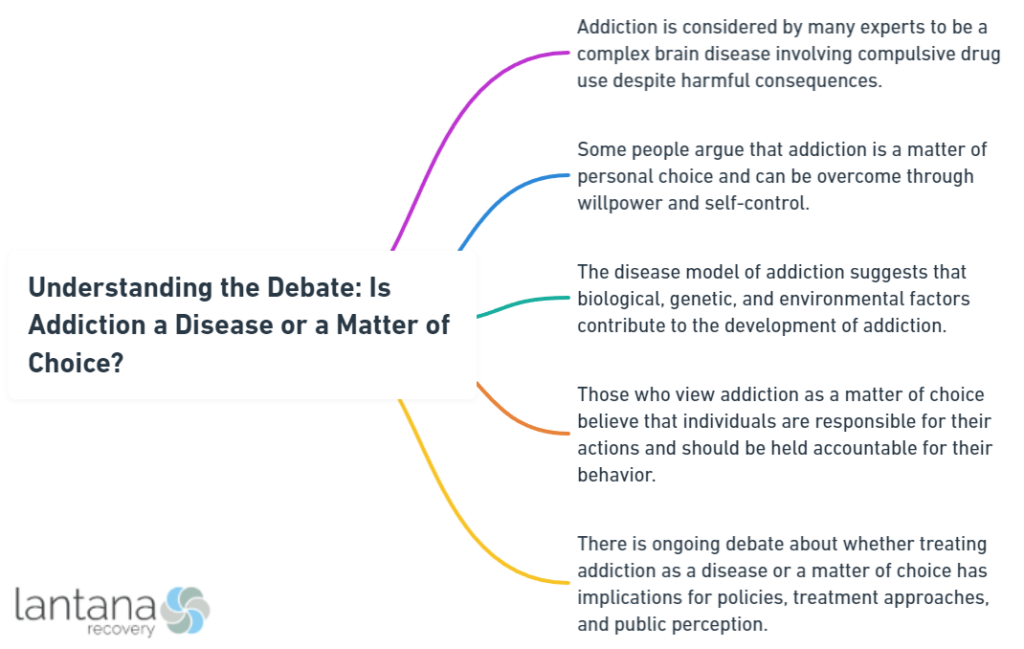Is addiction a disease? Across the medical community, the consensus grows: addiction is a chronic brain disorder. Key authorities, such as the American Society of Addiction Medicine, endorse this viewpoint, emphasizing its neurological underpinnings. Yet, there is a counterargument that highlights personal choice and environmental influences. Through exploration and expert insight, this article seeks to navigate these complex waters, offering clarity and perspective on one of modern medicine’s most pressing questions.
Key Takeaways
- Addiction is recognized by medical authorities as a chronic brain disorder, influenced by genetic factors and biological changes in the brain, which makes it comparable to other chronic diseases in its management and treatment.
- The opposing view to the disease model is the choice model, which considers addiction as a result of behavioral choices, influenced by a person’s environment, personal agency, and socio-economic factors, highlighting the importance of personal decision-making in overcoming addiction.
- Effective treatment for addiction often requires an integrated approach, addressing co-occurring mental health disorders, with support for various treatment modalities and aftercare, emphasizing the need for long-term management and prevention strategies.
Exploring the Disease Model of Addiction
The disease model of addiction paints a picture of a relentless foe, one that hijacks the brain and rewrites the rulebook of human behavior. Esteemed medical authorities, including the American Society of Addiction Medicine and the National Institute on Drug Abuse, classify addiction as a chronic brain disorder. This is not a fleeting ailment but a formidable adversary, likened to a shadow that lingers, characterized by a compulsion that defies reason and persists despite the wreckage left in its wake.
As we set our sights on the internal battleground of the brain, the genetic blueprints that influence our susceptibility, and the biological factors contributing to chronic disease parallels, we uncover a narrative where addiction is as much about biology as it is about behavior. It’s a story that challenges the stigma and reshapes the conversation around substance use disorders, paving the way for compassionate and evidence-based interventions.

The Brain Chemistry Altered by Addiction
Venture into the realm of brain chemistry, and you’ll find that addiction is a master of manipulation, altering neural pathways with a deftness that rivals the most skilled puppeteer. It weaves its influence through the circuits of reward, stress, and self-control, leading to compulsive drug-seeking behaviors that can persist long after the substance has left the system. Take cocaine, for example, a substance that transforms the brain’s reward pathway, the nucleus accumbens, into a veritable fortress of addiction, fortified with stronger, more numerous neural connections.
These brain changes are more than mere footprints; they represent a ‘hard-wiring’ of behaviors related to drug use, commandeering judgment and decision-making. The alterations in critical areas of the brain, such as the prefrontal cortex, epitomize the profound impact addiction has on brain function, akin to the damage wrought by chronic diseases on organ function.
The Role of Genetic Factors in Substance Use Disorders

In the genetic lottery of life, our DNA plays a significant role in shaping our vulnerability to addiction. From the common single nucleotide variants associated with drug addiction to the dopamine system genes linked to opioid abuse, our genetic makeup can be both a shield and a sword in the battle against substance use disorders. The clock genes, responsible for our circadian rhythms, also join the fray, adding another layer of genetic influence over alcohol abuse. Understanding one’s family history can provide valuable insights into these genetic factors and their potential impact on substance use.
Inheriting a predisposition to addiction isn’t a life sentence but rather a piece of a larger puzzle. With genetics accounting for 40-60% of the risk for addiction, the interplay between our inherited traits and the environment we navigate is complex and dynamic. The intricacies of this interaction are illuminated by how environmental cues and conditioned learning come to shape our behaviors, underscoring the multifaceted nature of addiction.
Chronic Condition Characteristics in Addiction
Comparable to the ebb and flow of chronic diseases like diabetes and heart disease, addiction disrupts the normal functioning of the brain, leaving a trail of harmful effects and necessitating a vigilant, long-term management strategy. It’s a condition that demands a recalibration of life’s compass, as the altered brain reward pathway beckons with biological and behavioral responses that are as persistent as they are destructive.
However, the story of addiction doesn’t end with a relapse; much like other chronic conditions, a return to substance use is not a failure but a signpost, a signal to revisit and refine the treatment approach. Managing addiction is a marathon, not a sprint, requiring continuous lifestyle alterations and adherence to treatment strategies that mirror the sustained efforts in managing other chronic diseases.
Alcohol Rehab South Carolina
If you or someone you know is struggling with alcohol addiction, seeking alcohol rehab in South Carolina can provide the necessary support and resources for recovery. South Carolina offers various rehabilitation facilities equipped with experienced professionals who specialize in addiction treatment. These facilities often provide personalized treatment plans tailored to individual needs, ensuring comprehensive care and support throughout the recovery journey. From detoxification programs to therapy sessions and aftercare support, alcohol rehab centers in South Carolina strive to address the physical, psychological, and emotional aspects of addiction. Additionally, many facilities may offer alternative therapies, such as art therapy or yoga, to complement traditional treatment methods and promote holistic healing. Choosing a reputable alcohol rehab center in South Carolina can significantly increase the chances of achieving long-term sobriety and reclaiming a healthier, happier life.
Addiction as a Behavioral Phenomenon: The Choice Argument
Opposing the disease model is a narrative that frames addiction as a consequence of behavioral choices. Here, addiction emerges from the tapestry of everyday decisions, as suggested by Gene Heyman in his book, where the repeated choice to engage in drug use can forge the chains of addiction. This perspective doesn’t merely cast addiction as a series of unfortunate decisions; it’s a clarion call to explore the underpinnings of choice processes to devise effective prevention and treatment strategies.
The choice model does not exist in isolation; it’s influenced by the fabric of our lives. Family responsibilities and financial stability have been shown to significantly impact the decision to break free from drug abuse, underscoring the role of personal decision-making in the journey from addiction to recovery. Moreover, social relationships, like marriage, can offer alternative, more fulfilling rewards that rival the transient allure of substance use.
In the end, behaviors that stimulate the brain’s reward system, even those as seemingly innocuous as scrolling through social media, can become addictive, showcasing the profound effect of our actions on our daily lives.
The Impact of Environmental Risk Factors

The environments we inhabit are rife with environmental factors that can either nudge us towards or away from the path of addiction. Family conflicts, the agonies of stress and divorce, and the silent whispers of substance misuse within the family walls can all contribute to one’s risk of falling prey to addiction. Adolescents, in particular, are vulnerable as peer pressure intertwines with a still-developing brain to create a potent recipe for substance use.
Our societal landscape, with its cultural norms and pervasive media, wields a subtle yet powerful influence on how we perceive and engage with substances. From the marketing of alcohol to the glamorization of drug use in movies, these elements can serve as a catalyst for addictive behaviors. It’s a complex equation, one where addiction likelihood hinges on a delicate balance of risk and protective factors, each person’s equation variable and unique.
Protective Factors and Personal Agency

While risk factors can entice us towards addiction, protective factors and personal agency stand as bulwarks against its tide. Simple measures, like setting boundaries on social media consumption to avoid content that normalizes substance use, can act as a shield, safeguarding us from the siren call of addiction. The company we keep can also fortify our resolve, as connections with those who champion sobriety can provide a social buttress, reinforcing our capacity to resist substance use.
The journey of recovery is a testament to the power of personal agency. Through proactive steps and healthy lifestyle choices, individuals embody the essence of taking charge of their destiny, preempting the grip of addiction. Recovery programs that encourage clients to actively participate in their care planning celebrate the central role of personal agency, echoing the idea that one’s narrative can be reshaped towards hope and empowerment.
In setting boundaries and crafting strategies for future challenges, individuals in recovery demonstrate a profound exercise of will, steering their life’s ship through tempestuous seas towards the horizon of sustained sobriety.
Is Rehab Free?
The question of whether rehab is free is complex and varies depending on several factors. In some cases, individuals may be eligible for free or subsidized rehabilitation programs through government-funded initiatives or nonprofit organizations. These programs often aim to provide support to individuals who cannot afford the cost of rehabilitation on their own. However, the availability of free rehab programs may be limited and may not always meet the specific needs of every individual seeking treatment. Additionally, private rehabilitation facilities typically require payment, either through insurance coverage or out-of-pocket expenses. It’s essential for individuals seeking rehabilitation to research their options thoroughly, including any potential financial assistance or payment plans available to them. Ultimately, while some rehab services may be free or low-cost, others may require a significant financial commitment.
Mental Health and Substance Abuse: A Dual Approach
Peering into the intertwined worlds of mental health and substance abuse, we find that addressing one without the other is akin to tending to a tree’s branches while neglecting its roots. Integrated treatment models are indispensable for those with dual diagnoses, as they offer a more holistic and effective path to recovery. The scars of traumatic experiences, such as abuse or prolonged stress, can drive individuals towards drugs or alcohol as a means to dull the sharp edges of PTSD symptoms and other mental disorders. Some key points to consider are:
- Integrated treatment models are essential for individuals with dual diagnoses.
- Traumatic experiences can lead to substance abuse as a coping mechanism.
- Addressing both mental health and substance abuse is crucial for effective recovery.
In the world of addiction medicine, the recognition of co-occurring disorders has led to specialized treatments that marry cognitive-behavioral therapy with comprehensive care in residential settings for those with intricate needs. Research efforts are honing in on the intersection of substance use, HIV, and related comorbidities, striving to understand and address the full spectrum of challenges faced by individuals grappling with these concurrent conditions.
The Diagnostic and Statistical Manual’s View on Addiction
In the quest for understanding and treating substance use disorders, the Diagnostic and Statistical Manual (DSM-5-TR) serves as a beacon, guiding clinicians through the murky waters of diagnosis. Recognized by the American Psychiatric Association, the DSM-5-TR encompasses criteria for a wide range of substance-related disorders, carefully distinguishing ongoing use despite the problems caused by the drugs.
The manual lays out 11 criteria to evaluate substance use disorders, which can help in identifying a specific substance use disorder. These criteria include:
- Physical dependence
- Risky use
- Social problems
- Impaired control
Clinicians rely on these criteria to gauge the severity of the disorder, crafting more accurate diagnoses and treatment plans that are tailored to the individual’s specific needs.
Treatment Approaches for Addiction

The landscape of addiction treatment is a mosaic of approaches, each tailored to address the unique facets of substance use disorders. The National Institute on Drug Abuse advocates for a comprehensive approach to substance abuse treatment that weaves together medications, behavioral therapies, and ongoing support to nurture the seeds of recovery. Cognitive-behavioral therapy equips individuals with the skills to navigate the road to recovery, while medications such as bupropion and naltrexone stand as sentinels, guarding against the lure of cravings and the specter of relapse.
In the realm of professional treatment, the bond between client and mental health professional is foundational, fostering trust and enhancing personal agency. Detoxification, a critical first step, must be managed by healthcare professionals to navigate the treacherous waters of potentially life-threatening withdrawal symptoms. From the sturdy framework of residential treatment to the flexible rhythms of intensive outpatient programs, each individual’s treatment plan is a tapestry woven from their unique experiences and challenges.
Residential Treatment and Intensive Outpatient Programs
Within the continuum of care, residential treatment stands as a lighthouse, offering a beacon of hope and structured support for those navigating the stormy seas of addiction. The immersive environment of residential rehab provides a sanctuary where clients can:
- Focus wholeheartedly on their recovery
- Receive round-the-clock support and supervision
- Participate in intensive therapy and counseling
- Learn and practice essential life skills
- Build a strong foundation for long-term sobriety
Residential treatment is a crucial step in the recovery journey, providing the necessary tools and support for individuals to heal and thrive.
On the other hand, intensive outpatient programs (IOPs) offer a bridge, allowing individuals to maintain their therapeutic progress while integrating back into their daily lives. The choice between residential and outpatient care is as personal as the journey of addiction itself, hinging on the individual’s needs and the severity of their addiction.
IOPs, with their condensed schedules and intensive treatment regimens, have been shown to foster significant improvements in substance use and mental health, proving that the depth of care is not solely the domain of inpatient settings.
The Importance of Aftercare and Support Groups
The odyssey of recovery doesn’t conclude with the end of formal treatment; aftercare and support groups are the compass and map that guide individuals through the uncharted territory of long-term sobriety. Aftercare encompasses a constellation of elements, including participation in support groups, outpatient care, and sober living arrangements, each essential for navigating the ebb and flow of recovery. The fellowship of recovery meetings, such as Alcoholics Anonymous or SMART Recovery, provides a crucible for forging strong, sober networks that can withstand the pressures and temptations of life post-treatment.
In the sober living homes, residents find an environment that offers:
- Freedom from the snares of drugs and alcohol
- A fertile ground for the continued growth of their recovery journey
- Regular check-ins and drug screenings that act as lighthouses, illuminating the early signs of potential relapse and ensuring the ship of sobriety remains on course
- A commitment to long-term aftercare, often extending beyond a year, as a testament to the enduring nature of recovery, a journey that, for some, may stretch even longer.
Is Addiction Genetic
The question of whether addiction is genetic has been a subject of extensive research and debate within the scientific community. Studies have consistently shown that genetic factors play a significant role in predisposing individuals to addiction. Research has identified specific genes that may increase susceptibility to addiction, particularly concerning substances like alcohol, nicotine, and opioids. However, it’s essential to recognize that genetics alone do not determine addiction; environmental factors, such as upbringing, social influences, and access to addictive substances, also contribute significantly. Furthermore, epigenetic mechanisms, which involve changes in gene expression without alterations to the underlying DNA sequence, can further complicate the relationship between genetics and addiction. Overall, while genetic predispositions can influence addiction vulnerability, a comprehensive understanding of addiction requires considering the complex interplay between genetic, environmental, and behavioral factors.
Withdrawal Symptoms and Managing Relapses
The cessation of substance use is not without its storms; withdrawal symptoms can range from the disquieting to the dire. Sleep disturbances, mood swings, and physical pain are but a few of the challenges faced on the road to recovery, while more severe symptoms like paranoia and seizures demand professional management and care. These symptoms, though intense, are but temporary guardians at the threshold of sobriety, their presence a transient test of resolve.
As the initial tempest of withdrawal subsides, the risk of relapse looms on the horizon, with environmental cues acting as sirens, beckoning back to past substance use. The first few months post-treatment are a critical period, where the newfound sobriety is most vulnerable, and the support network’s role becomes paramount. Differentiating between a lapse and a relapse is critical; while a lapse is a momentary slip, a relapse signifies a more significant regression, each requiring its own tailored response and support. The discovery of genetic factors like the Mpdz gene influencing withdrawal seizures underscores the complexity of addiction’s grip.
The National Institute on Drug Abuse’s Position on Addiction
The National Institute on Drug Abuse (NIDA) stands as a vanguard in the quest to understand and combat addiction, defining it as a chronic, relapsing brain disorder characterized by compulsive drug seeking and use, despite the havoc it wreaks. Far from a mere consequence of poor choices, NIDA positions addiction within the realm of complex brain disorders, demanding a nuanced understanding of its neurobiological, behavioral, and social underpinnings.
NIDA’s stance is not just a statement; it’s a call to action. By emphasizing the need for research that delves into the intricate mechanisms of addiction, NIDA seeks to:
- Forge more effective treatment and prevention strategies
- Acknowledge that addiction is not a battle to be fought alone but a societal challenge
- Require a concerted, informed approach grounded in empathy and science
Summary
As we reflect on the voyage through the complex seas of addiction, it’s clear that understanding its nature is not a choice between black and white, disease or decision, but rather a spectrum that encompasses both. The disease model of addiction, with its altered brain chemistry, genetic factors, and chronic condition parallels, offers a compelling narrative supported by medical expertise and research. Conversely, the choice model advocates for a deeper exploration into the behavioral aspects and environmental influences that shape the journey of addiction.
In synthesizing these models, we arrive at a more nuanced and compassionate understanding of addiction, one that informs treatment approaches and underpins our collective efforts towards recovery. Let this exploration be a beacon of hope, a testament to the resilience of the human spirit, and an invitation to continue the conversation with empathy, curiosity, and an unwavering commitment to those on the path to recovery.
Frequently Asked Questions
What is the family disease model of addiction?
The family disease model of addiction sees addiction as a disease that affects the entire family, leading to enabling and codependent behaviors among family members. It views addiction as impacting the family as a whole.
What are the 5 recovery skills?
The 5 recovery skills are communication and interpersonal skills, creative and critical thinking, problem solving and effective decision making, self-awareness, and assertiveness and self-control. These skills are essential for building resilience and the ability to cope.
Is addiction a brain disease True or false?
Yes, addiction is considered a brain disorder because it involves functional changes to brain circuits involved in reward, stress, and self-control, similar to other diseases like heart disease. Therefore, it is true.
What exactly changes in the brain when someone is addicted to drugs?
Addiction leads to alterations in brain circuits related to reward, stress, and self-control, making drug-seeking behavior compulsive and habitual, which can affect judgment and decision-making. These changes are akin to the impact of chronic diseases on organ function.
Is addiction solely determined by genetics?
While genetics play a significant role, addiction is also influenced by environmental factors and individual choices, making it a complex interplay of various elements. It’s not solely determined by genetics.









